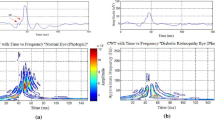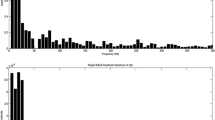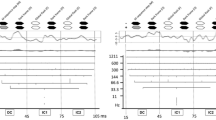Abstract
Background
Electroretinogram (ERG) plays an essential role in the diagnosis of retinal disease. Choosing appropriate methods could extract valuable information from ERG. In this study, a new criterion based on time–frequency domain analysis was proposed to investigate the retina in retinitis pigmentosa (RP) patients.
Materials and methods
The total number of 16 eyes from eight RP patients and 20 eyes from age-matched healthy subjects were assessed. The signals included photopic and scotopic ERGs. Continuous wavelet transform was applied to ERGs. Dominant frequencies were extracted, and the contours related to these dominant frequencies were selected. As a new criterion, the areas related to dominant frequency contours were considered a feature to differentiate the RP and normal groups. To better evaluate the proposed criterion results, the time-domain analysis characteristics of ERG were also considered.
Results
The results showed an increase in implicit time and reduced amplitude in RP patients (P < 0.05). A significant decrease of dominant frequencies and increasing their occurrence time were seen in ERG of RP patients. Also, in RP patients, the third dominant frequency was disappeared from the three main frequencies observed in photopic ERGs of normal subjects. The area criterion showed a significant decrease in RP groups (P < 0.05).
Conclusion
RP can cause changes in the time and time–frequency components of the ERG. The area index could represent a new view of the characteristics of the ERG in the time–frequency domain. This criterion can help the ophthalmologist to have a better evaluation of retinal disease.



Similar content being viewed by others
Abbreviations
- BCVA:
-
Best-corrected visual acuity
- COI:
-
Cone of influence
- CWT:
-
Continuous wavelet transform
- DWT:
-
Discrete wavelet transform
- ECG:
-
Electrocardiogram
- EEG:
-
Electroencephalogram
- ERG:
-
Electroretinogram
- FA:
-
Fourier analysis
- ffERG:
-
Full-field ERG
- ISCEV:
-
Clinical electrophysiology of vision
- LCA:
-
Leber's congenital amaurosis
- LogMAR:
-
Logarithm of the minimum angle of resolution
- OD:
-
Ocular dexter
- OPs:
-
Oscillatory potentials
- OS:
-
Ocular sinister
- PDR:
-
Proliferative diabetic retinopathy
- ROP:
-
Retinopathy of prematurity
- RP:
-
Retinitis pigmentosa
- SD:
-
Standard deviation
- SNR:
-
Signal-to-noise ratio
- STFT:
-
Short-time Fourier transform
References
Sahel JA, Marazova K, Audo I (2015) Clinical characteristics and current therapies for inherited retinal degenerations. Cold Spring Harb Perspect Med 5(2):a017111
Pardue MT, Allen RS (2018) Neuroprotective strategies for retinal disease. Prog Retin Eye Res 65:50–76
Sahel J, Bonnel S, Mrejen S, Paques M (2010) Retinitis pigmentosa, and other dystrophies. Dev Ophthalmol 47:160–167
Hamel C (2006) Retinitis pigmentosa. Orphanet J Rare Dis 1:40
Ruether K, Kellne U (1998) Inner retinal function in hereditary retinal dystrophies. Acta Anat 162:169–177
Natarajan S (2011) Retinitis pigmentosa: a brief overview. Indian J Ophthalmol 59(5):343–346
Hood DC, Birch G (1996) Abnormalities of the retinal cone system in retinitis pigmentosa. Vis Res 36:1699–1709
Sefandarmaz N, Behbahani S, Ramezani A (2020) A novel method for electroretinogram assessment in patients with central retinal vein occlusion. Doc Ophthalmol 140(3):257–271
Ebdali S, Hashemi B, Hashemi H, Jafarzadehpur E, Asgari S (2018) Time and frequency components of ERG responses in retinitis pigmentosa. Int Ophthalmol 38(6):2435–2444
Karimi HH, Jafarzadehpur E, Blouri B, Hashemi H, Sadeghi AZ, Mirzajani A (2012) Frequency domain electroretinography in retinitis pigmentosa versus normal eyes. J Ophthalmic Vis Res 7(1):34–38
Nair SS, Joseph KP (2014) Chaotic analysis of the electroretinographic signal for diagnosis. Biomed Res Int 2014:503920
Miguel Jimenez JM, Ortega S, Boquete L, Rodrı´guez-Ascariz JM, Blanco R (2011) Multifocal ERG wavelet packet decomposition applied to glaucoma diagnosis. BioMed Eng Online 10(37):37
Nair SS, Paul JK (2014) Wavelet-based electroretinographic signal analysis for diagnosis. Biomed Signal Process Control 9:37–44
Barraco R, Adorno DP, Brai M (2011) An approach based on wavelet analysis for feature extraction in the a-wave of the electroretinogram. Comput Methods Programs Biomed 104(3):316–324
McCulloch DL, Marmor MF, Brigell MG, Hamilton R, Holder GE, Tzekov R, Bach M (2015) ISCEV Standard for full-field clinical electroretinography. Doc Ophthalmol 130:1–12
Kinoshita O, Fontaine G, Rosas F, Elias J, Iwa T, Tonet J, Lascault G, Frank R (1995) Time- and frequency-domain analyses of the signal-averaged ECG in patients with arrhythmogenic right ventricular dysplasia. Circulation 91(3):715–721
Fahoum AS, Fraihat AA (2014) Methods of EEG signal features extraction using linear analysis in frequency and time-frequency domains. ISRN Neurosci 2014:730218
Villarejo MV, Zapirain BG, Zorrilla AM (2013) Algorithms based on CWT and classifiers to control cardiac alterations and stress using an ECG and a SCR. Sensors (Basel) 13(5):6141–6170
Kim J, Min SD, Lee M (2011) An arrhythmia classification algorithm using a dedicated wavelet adapted to different subjects. Biomed Eng Online 10:56
Mgdob HM, Torry JN, Vincent R, Al-Naami B (2003) Application of Morlet transform wavelet in the detection of paradoxical splitting of the second heart sound. Comput Cardiol 30:323–326
Yu L, Giurgiutiu V (2005) Advanced signal processing for enhanced damage detection with embedded ultrasonic structural radar using piezoelectric wafer active sensors. Smart Struct Syst 1(2):185–215
Kirby JF, Swain CJ (2013) Power spectral estimates using two-dimensional Morlet-fan wavelets with emphasis on the long wavelengths: jackknife errors, bandwidth resolution and orthogonality properties. Geophys J Int 194:78–99
Tiscareno MS, Hedman MM (2018) A review of Morlet wavelet analysis of radial profiles of Saturn’s rings. Philos Trans A Math Phys Eng Sci 376(2126):20180046
Fritz CO, Morris PE, Richler JJ (2012) Effect size estimates: current use, calculations, and interpretation. J Exp Psychol Gen 141:2–18
Hamasaki DI, Liu M, Qiu H, Fujiwara E, Lam BL (2002) The a-Wave latency in control subjects and patients with retinal diseases. Jpn J Ophthalmol 46(4):433–442
Hood DC, Birch DG (1996) Abnormalities of the retinal cone system in retinitis pigmentosa. Vis Res 36(11):1699–1709
Cabral T, Lima JR, de Carvalho Jr J, Kim JKOh, Levi SR, Park KS et al (2020) Comparative analysis of functional and structural decline in retinitis pigmentosas. Int J Mol Sci 21:2730
Marmor MF (1979) The electroretinogram in retinitis pigmentosa. Arch Ophthalmol 97:1300–1304
Falsini B, Iarossi G, Fadda A, Porrello G, Valentini P, Piccardi M et al (1999) The fundamental and second harmonic of the photopic flicker electroretinogram: temporal frequency-dependent abnormalities in retinitis pigmentosa. Clin Neurophysiol 110:1554–1562
Gouras P, Carr RE (1964) Electrophysiological studies in early retinitis pigmentosa. Arch Ophthalmol 72:104–110
Felius J, Swanson WH (1999) Photopic temporal processing in retinitis pigmentosa. Invest Ophthalmol Vis Sci 40:2932–2944
Cuenca N, Fernández-Sánchez L, Campello L, Maneu V, De la Villa P, Lax P et al (2014) Cellular responses following retinal injuries and therapeutic approaches for neurodegenerative diseases. Prog Retin Eye Res 43:17–75
Mitamura Y, Mitamura-Aizawa S, Katome T et al (2013) Photoreceptor impairment and restoration on optical coherence tomographic image. J Ophthalmol 2013:518170
Lu Y, Benedetti J, Yao X (2018) Light-induced length shrinkage of rod photoreceptor outer segments. Transl Vis Sci Technol 7(6):29
Berson EL (1992) Electrical phenomena in the retina. In: Hart WM (ed) Adler’s physiology of the eye, 9th edn. Mosby, USA, pp 641–708
Campochiaro PA, Mir TA (2018) The mechanism of cone cell death in retinitis pigmentosa. Prog Retin Eye Res 62:24–37
Birch DG (2006) Retinitis pigmentosa. In: Heckenlively JR, Arden GB (eds) Principles and practice of clinical electrophysiology of vision, 2nd edn. MIT Press, UK, pp 781–794
Birch DG, Sandberg MA (1987) Dependence of cone b-wave implicit time on rod amplitude in retinitis pigmentosa. Vis Res 27(7):1105–1112
Gauvin M, Dorfman AL, Trang N, Gauthier M, Little JM, Lina JM, Lachapelle P (2016) Assessing the contribution of the oscillatory potentials to the genesis of the photopic ERG with the discrete wavelet transform. Biomed Res Int 2016:2790194
Rogala T, Brykalski A (2005) Wavelet feature space in computer-aided electroretinogram evaluation. Pattern Anal Appl 8:238–246
Nair SS, Joseph KP (2014) Wavelet-based electroretinographic signal analysis for diagnosis. Biomed Signal Process Control 9:37–44
Kundra H, Park JC, McAnany JJ (2016) Comparison of photopic negative response measurements in the time and time-frequency domains. Doc Ophthalmol 133(2):91–98
Barraco R, Bellomonte L, Brai M (2007) Time-frequency behavior of the a-wave of the human electroretinogram. In: Proc. 11th Mediterranean Conference on Medical and Biomedical Engineering and Computing, Berlin, Heidelberg, 919–922.
Miguel-Jimenez JM, Velasco RB, Vazquez LB, Ascariz JM, Villa Polo (2008) Multifocal electroretinography, glaucoma diagnosis using the wavelet transform. In: Canadian Conference on Electrical and Computer Engineering CCCEC, pp. 867–870
Barraco R, Adorno DP, Brai M (2011) ERG signal analysis using wavelet transform. Theory Biosci 130:155–163
Toufik B, Mokhtar N (2012) The wavelet transform for image processing applications. Intech, London
Özmert E, Arslan U (2020) Management of retinitis pigmentosa by Wharton’s jelly derived mesenchymal stem cells: preliminary clinical results. Stem Cell Res Ther 11:25
Busskamp V, Picaud S, Sahel J et al (2012) Optogenetic therapy for retinitis pigmentosa. Gene Ther 19:169–175
Gauvin M, Lina JM, Lachapelle P. Advance in ERG analysis: From peak time and amplitude to frequency, power, and energy. BioMed Research International Volume 2014, Article ID 246096, 11 page
Jones BW, Pfeiffer RL, Ferrell WD, Watt CB, Marmor M, Marc RE (2016) Retinal remodeling in human retinitis pigmentosa. Exp Eye Res 150:149–165
Acknowledgements
This article is taken from the disease registry, titled "The Iranian National Registry of Inherited Retinal Dystrophy (IRDReg®)" and code number of IR.SBMU.ORC.REC.1396.15 from the ethics committee supported by the deputy of research and technology in Shahid Beheshti University of medical sciences (http://dregistry.sbmu.ac.ir).
Funding
Ophthalmic Research Center of Shahid Beheshti University of Medical Sciences funded this work.
Author information
Authors and Affiliations
Corresponding author
Ethics declarations
Conflict of interest
None of the authors have any conflicts of interest to disclose.
Ethical approval
All procedures performed in studies involving human participants were according to the standards of the Ethics Committee of the Ophthalmic Research Center, Shahid Beheshti University of Medical Sciences, Tehran, Iran, and correlated with the 1964 Helsinki Declaration and its later amendments or comparable ethical standards.
Statement of human rights
All procedures performed in studies involving human participants were in accordance with the ethical standards of the institutional research committee and with the 1964 Declaration of Helsinki and its later amendments or comparable ethical standards.
Statement on the welfare of animals
This article does not contain any studies with animals performed by any of the authors.
Informed consent
Informed consent was obtained from all participants recruited in this study.
Additional information
Publisher's Note
Springer Nature remains neutral with regard to jurisdictional claims in published maps and institutional affiliations.
Rights and permissions
About this article
Cite this article
Sabbaghi, H., Behbahani, S., Daftarian, N. et al. New criteria for evaluation of electroretinogram in patients with retinitis pigmentosa. Doc Ophthalmol 143, 271–281 (2021). https://doi.org/10.1007/s10633-021-09843-x
Received:
Accepted:
Published:
Issue Date:
DOI: https://doi.org/10.1007/s10633-021-09843-x




